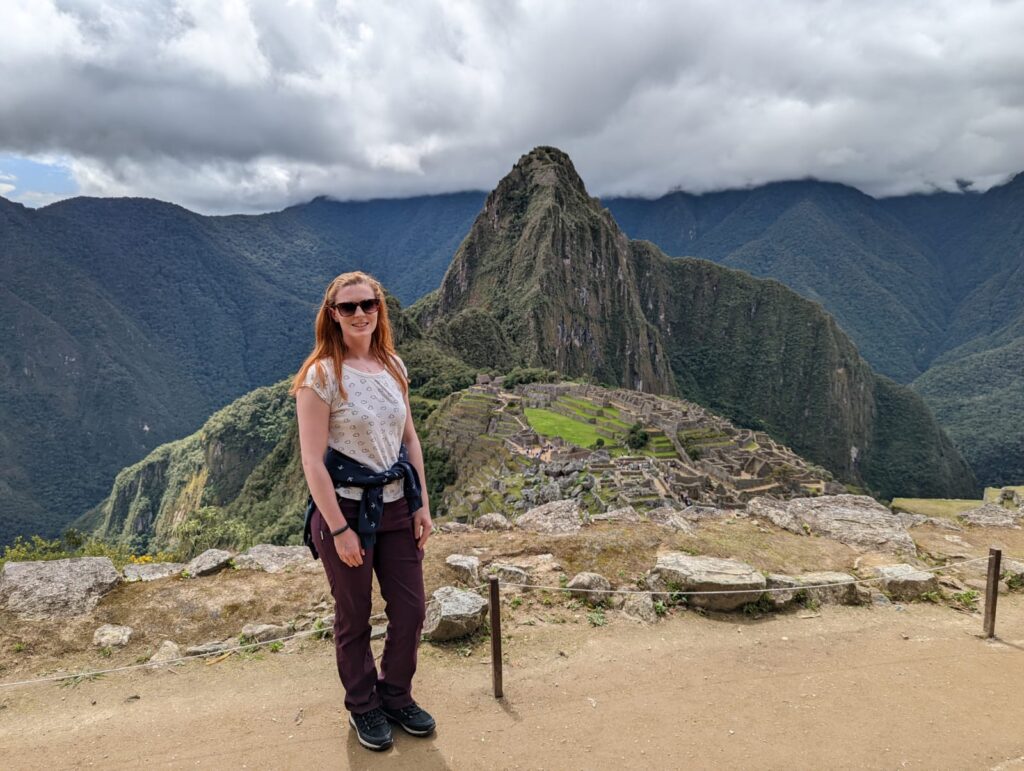A Journey through Time and Terrain: Taking the Train to Machu Picchu
Wondering what it is like to explore Machu Picchu with an organised tour company? Not sure where to start? Read on to find out about my stress free day trip to Machu Picchu.

Machu Picchu is an Inca citadel dating back to the 15th century. Perched high in the Andes Mountains of Peru, approximately 75km (46 miles) from Cusco, are the breathtaking terraces, marvelous stone structures, temples and amazing views. This UNESCO World Heritage site is a captivating destination that draws people from all over the world to immerse yourself in history and culture.
History

Machu Picchu was built in the 15th Century by the Inca civilization during the reign of the Inca emperor Pachacuti. The purpose of Machu Picchu is still a subject of debate among historians, but it’s believed to have served as a royal estate or a religious and ceremonial center.
The site was abandoned in the 16th Century and largely forgotten by the outside world. It’s speculated that the site was abandoned due to the Spanish conquest, though there’s no concrete evidence confirming this. Another theory suggests that it was abandoned due to an outbreak of smallpox brought by Spanish conquistadors.
Machu Picchu wasn’t rediscovered until the 20th Century, by an American historian and explorer Hiram Bingham in 1911. The site was found accidentally whilst he was searching for the lost city of Vilcabamba. Bingham’s expedition brought international attention to Machu Picchu, and since then, it has become one of the most iconic and visited archaeological sites in the world.
Machu Picchu was designated a UNESCO World Heritage Site in 1983, recognising its cultural and historical significance.
Despite decades of research, many aspects of Machu Picchu remain a mystery. Its precise purpose, the reason for its abandonment, and the methods used in its construction continue to be topics of debate.
My experience – booking the trip!
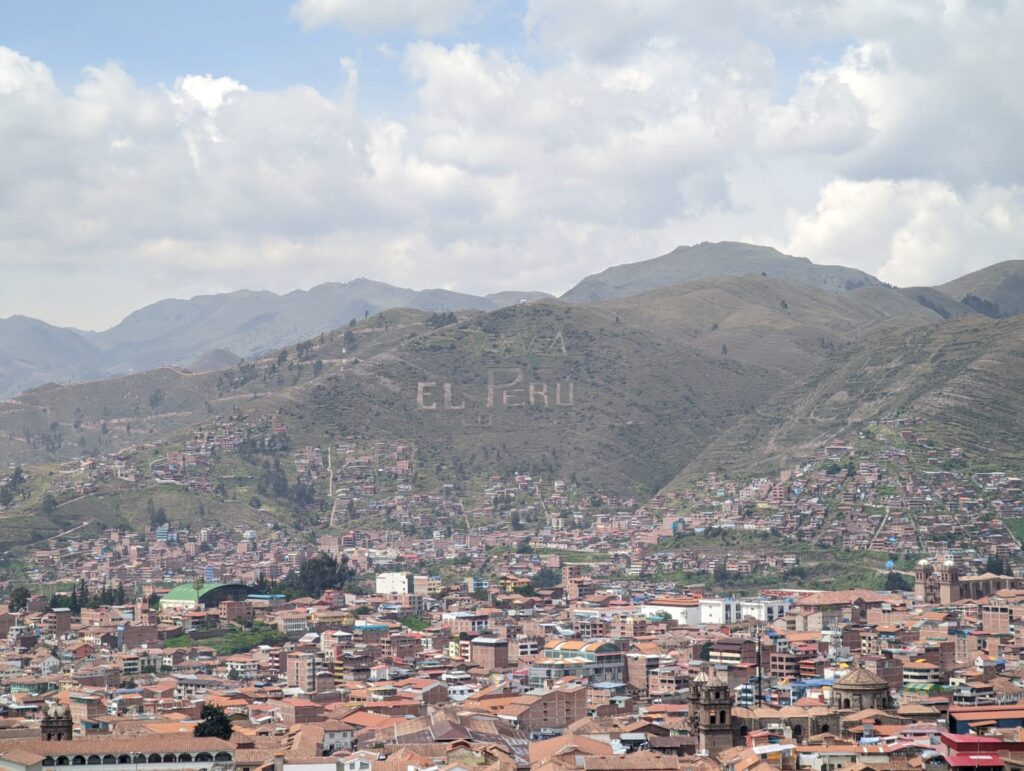
I was visiting Cusco for a short couple of days in April therefore I weighed up the best options for seeing machu picchu in the time given. I ruled out hiking the Inca trail due to not having enough days to complete this. I decided to use an organised tour to explore Machu Picchu in one day using the train. This was a very convenient and comfortable option, which I would recommend if you are short on time or struggle with physical ability.
There are other ways to explore Machu Picchu. If you don’t want to cram a full itinerary into one day. You can take the train for a 2 day visit, staying overnight in a hotel in Agues Calientes. Another option is walking the famous Inca trail which is a 4 day trek walking along the track the incas once did, although this is camping experience with no showers. You will need to apply for a permit beforehand in order to do this trail. There is a shorter version of the inca trail which is 2 days. 1 day of this is spent on the trail before reaching Agues Calientes.
I used a company called Haku Travel using the following website to book the trip. https://www.findlocaltrips.com/tour-details/train-machu-picchu-haku-travel
The price varied from $324 – $364 per person depending upon the type of train ticket selected. The trip included:
- A mini-bus between Cusco – Ollantaytambo – Cusco
- Train ticket between Ollantaytambo – Agues Calientes – Ollantaytambo
- Bus up from Agues Calientes to Machu Picchu
- Entrance to Machu Picchu
- Professional tour guide
Once I had booked online and the trip was confirmed I had to send a copy of my passport via email prior to the trip. My hotel was not listed within the pick-up stops, so I chose Hotel Plaza De Armas Cusco which was a central location.
The night before the scheduled trip I was contacted via whatsapp with a confirmed pick-up time and location. The message also contained the tickets for the train which detailed the carriage, seat number and departure time. Just to note – even if you book as part of a group you might not be sat together on the train. I was also sent the Machu Picchu entry tickets stating the entry time. Some people in the group had an entry time of 11am and some 12pm. I had a 12pm ticket. A bus ticket up to the entrance was included too.
The pick up time was earlier than I expected – 03:15! Safe to say the minivan was a good 15 minutes late, but once it had arrived and the other stops completed we headed towards Ollantaytambo Train Station. This journey took approximately 1 hour 45 minutes.
The Train Ride

The train was scheduled to depart at 06:10, and you could board the train approximately 20 minutes prior to departure. They recommend you get to the station at least half an hour before boarding due to the amount of people trying to get their tickets checked before you can access to the platform.
Perurail was the train company I had pre-booked with and I opted for the train expedition ticket which is the lower cost economy service. The seats were comfortable and sat in two’s usually facing another seat of two. There were other ticket choices including vistadome, vistadome observatory, titicaca and Hiram Bingham offering a more first class luxurious experience, however you had to pay extra for this.
The rail tracks follow the path of the ancient Inca Trail and Urubamba River – the historical route that once connected the Inca Empire. The rail journey takes you through the incredible Sacred Valley, a lush and vibrant landscape. As the train winds its way through the Andes, you see panoramic views of terraced fields, quaint villages, and the meandering Urubamba River. Breathtaking scenery unfolds at every turn along the way so make sure you have your camera ready! The train journey took approximately 90 minutes before arriving in Aguas Calientes.
Arriving in Aguas Calientes
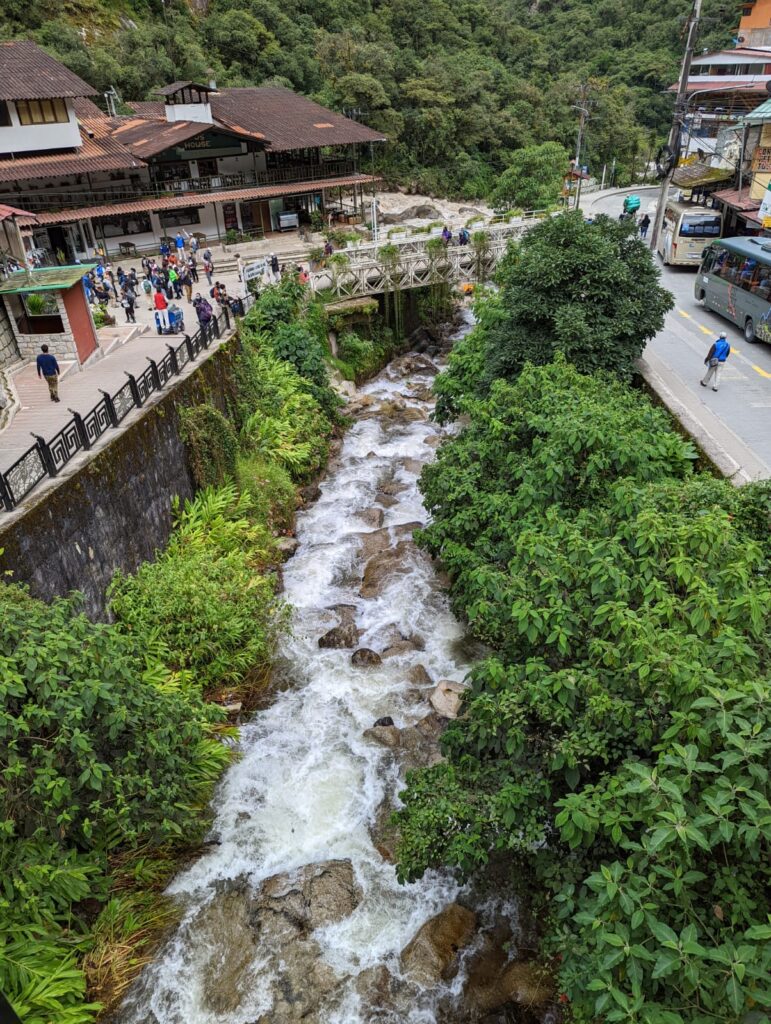
The train pulled into Aguas Calientes at 07:45am. Upon arrival you could instantly hear the sounds of the Vilcanota River, which flows through the heart of Aguas Calientes. This is the last stop before Machu Picchu and the town is only accessible by train or foot.
This town was originally known as Machu Picchu Pueblo, but Aguas Calientes earned its current name from the thermal springs that bubble up from the earth’s depths. Aguas Calientes served as a vital hub for the construction of Machu Picchu, with workers and supplies using the narrow streets as a route up to the mountain.
There are several hotels, restaurants, cafes and markets in this small town. You can try traditional Peruvian cuisine, such as cuy (guinea pig), quinoa soup, stews or ceviche, choosing from an array of dishes using locally sourced ingredients. Many are tempted by a refreshing pisco sour after exploring Machu Picchu. You could also browse the markets filled with colorful textiles and handcrafted souvenirs. Travelers also often indulge in a relaxing soak in the thermal baths. Accommodation options in Aguas Calientes range from budget hostels to luxury hotels, ensuring that travelers of all preferences and budgets find a comfortable place to rest before or after their Machu Picchu adventure.
I only had a couple of hours exploring the town, however if you have more time, a popular route is a hike to the mountain peak of Huayna Picchu (you need to prebook a ticket for this), offering panoramic views of Machu Picchu and the Urubamba River below. This is a challenging climb with narrow trails and steep stairs. Or you can wander along the winding trails of the Mandor Valley, and discover the hidden waterfalls! There is also the Manuel Chavez Ballon Site Museum, which provides valuable insights into the history and significance of Machu Picchu.
From Aguas Calientes, you can either take a bus or embark on a challenging but rewarding hike to reach the ancient citadel. The bus ticket up the mountain was included in the tour package and I was able to queue to board the bus at 11:00. The buses run every 10 minutes and it takes 30 minutes to ride up the mountain. The bus stop is in the centre of the town. Or if you choose to walk up this takes approximately 1 hour 40 minutes.
Exploring Machu Picchu
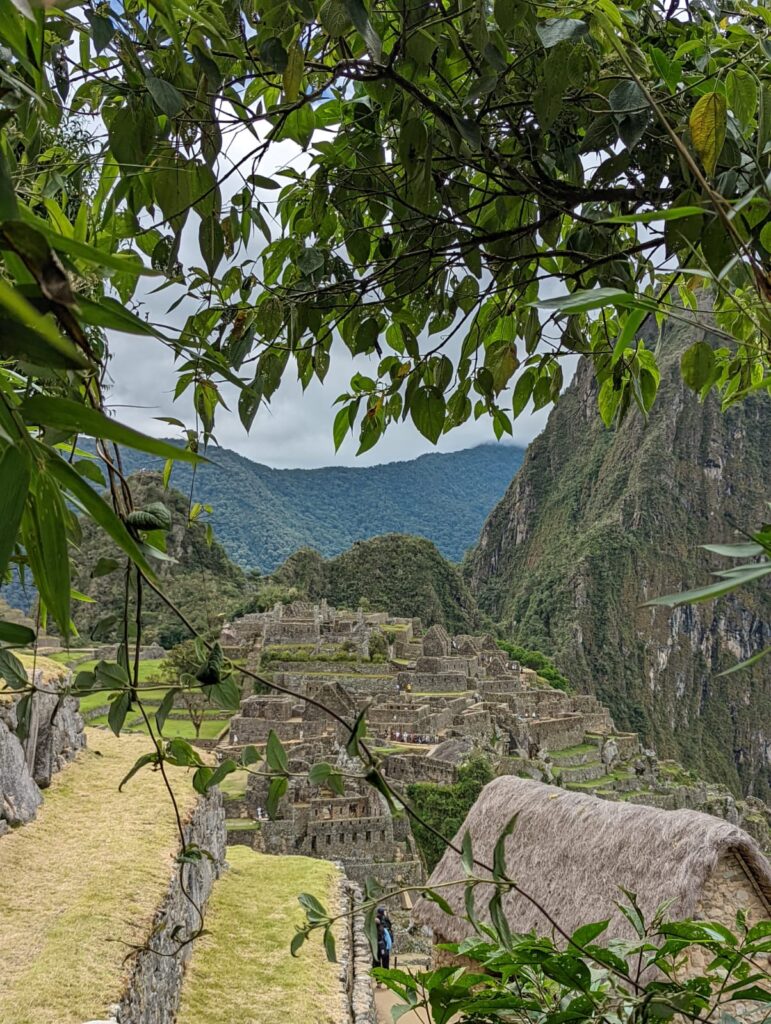
When I got off the bus I could see the ticket office with queues of people waiting for their entry time. All tourists must be led by a tour guide in order to preserve the world heritage. Groups contain a maximum of 10 people, my group had 6 plus the tour guide. The tour duration is usually 2 hours 30 minutes per group, however the group has up to 4 hours to visit the site. Reentry to the site is prohibited, therefore make sure you use the toilet facilities (located near the ticket desk) before you enter.
The tour guide was very friendly and knowledgeable. He took us on the main route – circuit 2 which includes upper and lower levels. It’s the main circuit particularly if you are on a single day ticket and want to see a good proportion of the site and the best viewpoints. A one way system was introduced during the pandemic, and so far remains in place to help spread the crowds.
Once through the entrance gate the first sight to behold is the breathtaking panorama of terraced fields cascading down the mountainside. Here, the Incas once maintained crops to sustain their civilization.
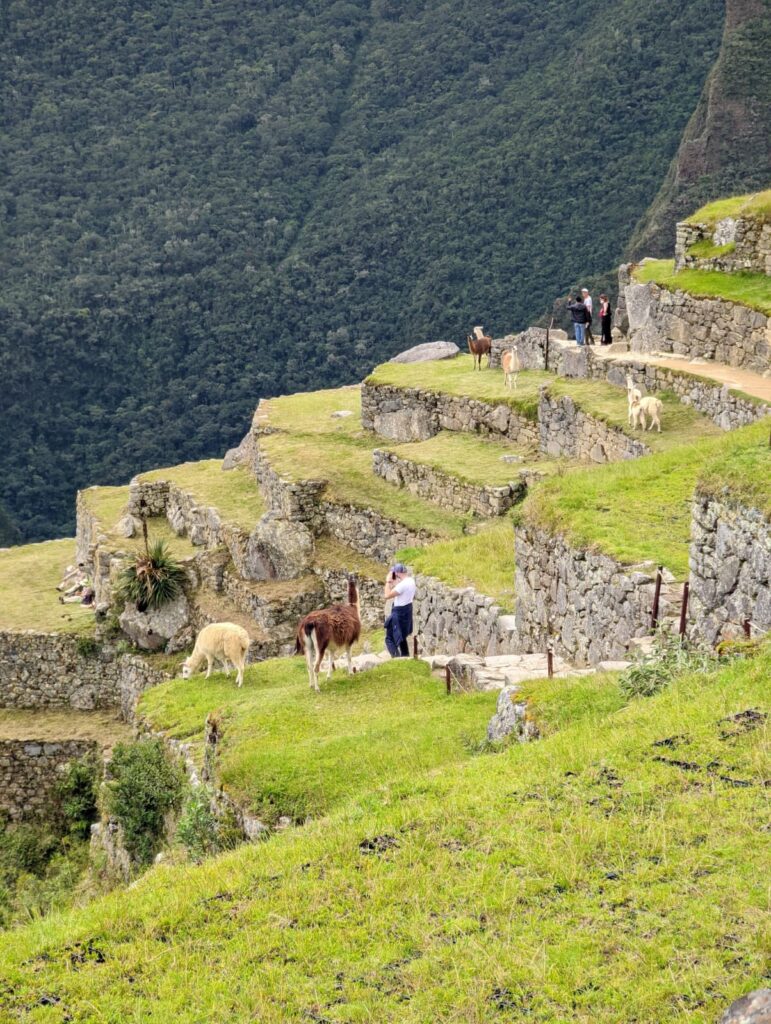
We explored the upper part of the trail first, stopping at many photo spots along the way. We also passed the start of the trailhead for the Machu Picchu mountain and Incagate. You require a different ticket type to explore these.
Along the way, stone structures emerge from the greenery, and the houses of the nobles (small pointy roofed buildings) appear in sight. It is believed that these houses were for Inca royalty.
Passing by the Intiwitana stone, a carved rock likely used for astronomical and spiritual purposes, before reaching Sacred Rock. This granite rock is shaped like a mountain and once held rituals and ceremonies. Here, the Temple of the Three Windows also stands. Known for its large walls and three trapezoidal-shaped windows which the sun’s rays would shine through onto the Sacred Plaza.
Continuing along the circuit, you see the workers’ houses and temple of condor where offerings such as sacrificial animals, food or textiles were presented before god.
You can also see a view of the Royal Palace, where court was once held, and the temple of the sun – only the priests or highest ranking in the Inca Empire were allowed in here. To get up close you would need to walk on circuit 3 or 4.
The guided trail took approximately just over two hours. We had paid for a bus to take us back down (as this was not included in the organised day tour), but there is the option to walk back down also.
The Train back was at 14:50, so the afternoon felt a little rushed. It is important to note that the pick-up location to get back on the train is different from the drop off location.
By the time we had ridden the train back and driven back to cusco it was 19:00. This was earlier than the advertised schedule which detailed the train returning at 18:20, and back in cusco at 22:20!

Do I need a reservation?
All tickets should be reserved in advance. During the high tourist season tickets are likely to sell out. There are a set number of tickets available each day, so if you are short on time make sure you book your ticket in plenty of time.
How to get to Machu Picchu by train, and how long does it take?
It is recommended you book tickets in advance online as soon as you know your date of travel.
Once you have arrived in the city of cusco, you need to make your way to your departing rail station (unless you book with a tour company that picks you up from Cusco) either by taxi, organised tour or public transport. You are advised to arrive at the train station 30 minutes before your departure time.
The 3 stations are:
- Poroy station: The train journey to Agues Calientes takes approximately 3.25 hours
- Urubamba station: The train journey to Agues Calientes takes approximately 2.5 hours
- Ollantaytambo station: The train journey to Agues Calientes takes just less than 2 hours
Regardless of which train station you choose to start your journey all trains will travel to the final destination of Agues Calientes. From here you can take the bus up to the Machu Picchu gate or walk up.
Do I need to reserve my train tickets?
Tickets are usually in high demand, so make sure you pre-book once you know your itinerary. To book the train tickets yourself, use one of two companies’ websites that provide this service, either Peru Rail or Inca Rail.
Are there conditions to board the train to Machu Picchu?
You must bring your train ticket and identification document or passport to board the train. The ticket is checked both before and during the trip. If you cannot show proof of your ticket you will not be able to board the train.
What other tickets do I need for Machu Picchu?
You will likely need 3 tickets to get into Machu Picchu – the train to Agues Calientes, bus up to the Machu Picchu entrance gate and the entrance ticket. An adult bus ride ticket costs $12 one way or $24 for a return. You can either buy these in advance from the website or on arrival to Agues Calientas at the Consettur office.
Are there different tickets for Machu Picchu entry?
There are different entry tickets to choose from. The general entry ticket “Llaqta De Machupicchu’ covers circuits 1-4. The other tickets include one of the mountain hikes or Inca bridge along with a set circuit. A list of entry tickets are listed below. The prices can vary depending on whether you a foreigner, andean community, student etc.
- Llaqta De Machupicchu (circuit 1, 2, 3 or 4)
- Circuit 4 + Waynapicchu Mountain
- Machupicchu Mountain + Circuit 3
- Circuit 4 + Huchuypicchu Mountain
- Circuit 1 or 2 + Inka Bridge
When can I enter Macchu Picchu?
Machu Picchu is open everyday from 6am to 5:30pm, it is not possible to visit Machu Picchu outside these times. The last entry slot starts at 3pm. When booking your admission ticket you have to select an entry time slot of 60 minutes. This cannot be changed / refunded once bought regardless of the reason.
Are there toilet facilities?
Once you have passed the Machu Picchu entry gate there are no toilets inside the historic area, so make sure you use the toilets in front of the gateway before entering, these are the last ones. You are not allowed to re-enter Machu Picchu once exiting so make sure this is not your reason for leaving.
What are the other circuits?
Circuits 1 and 2 include exploring the upper and lower part of Machu Picchu. Circuit 2 is the biggest circuit and covers a large amount of the upper and lower sections. Circuit 1 only covers half of the lower section.
Circuits 3 and 4 cover the lower section of Machu Picchu and are much more flatter circuits. Circuit 3 only covers a very short section of the lower section.
It is important to note that the circuits are changing from June 2024 – head to the website for more information.
Can I see all the Machu Picchu Temples?
The temples have different opening times as they are under restoration therefore you will need a ticket with the correct time slot for the temple you want to see. You will not be able to see all the temples in one day due to a 4 hour maximum stay on a general entry ticket.
Temple of the Condor – is open between 10am – 1pm, and can be found on all circuits
The temple of the sun – is open between 1pm – 4pm, and located on circuit 3 and 4 only.
Pyramid del Intiwatana – open between 7am-10am, on and located on circuit 2 and 4 only.
So was the trip worth it?
There were many pros and cons to exploring Machu Picchu on a one day organised tour. The biggest downside was not having any control over the timings, including train timings and the Machu Picchu entry timings. You also did not get the opportunity to explore any of the additional walking trails. On the positive side, it was a stress free day with no organisation required and I got some great photos of Machu Picchu! Not everyone wants to hike up to Machu Picchu or is able to do so, and this option still allows you to see, explore and learn about this amazing wonder! Its strategic location atop a ridge between two peaks provides panoramic views of the surrounding mountains and the Urubamba River below, however Machu Picchu is more than a destination; it’s a journey through history, nature, and full of adventure.
